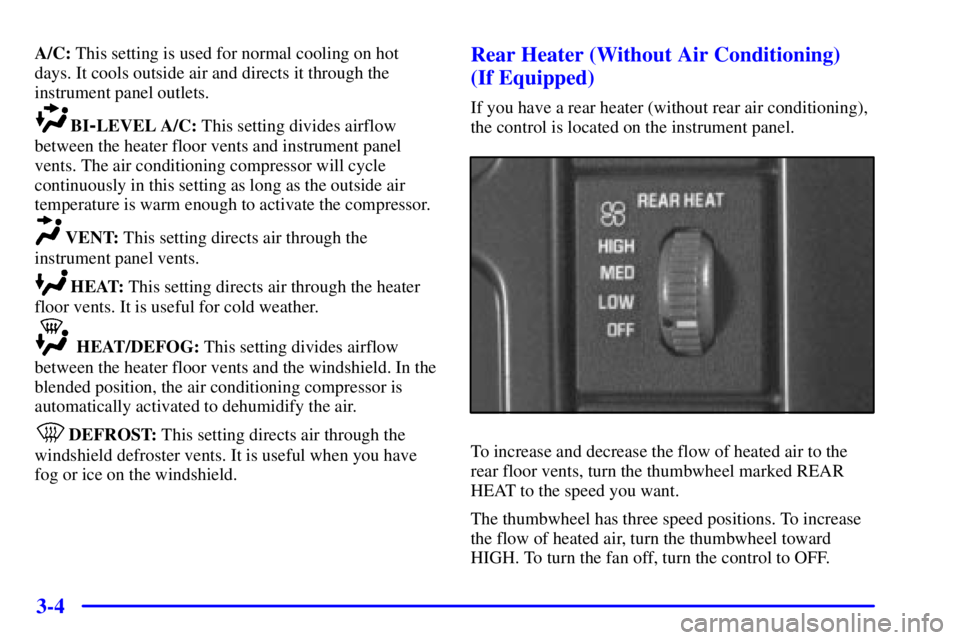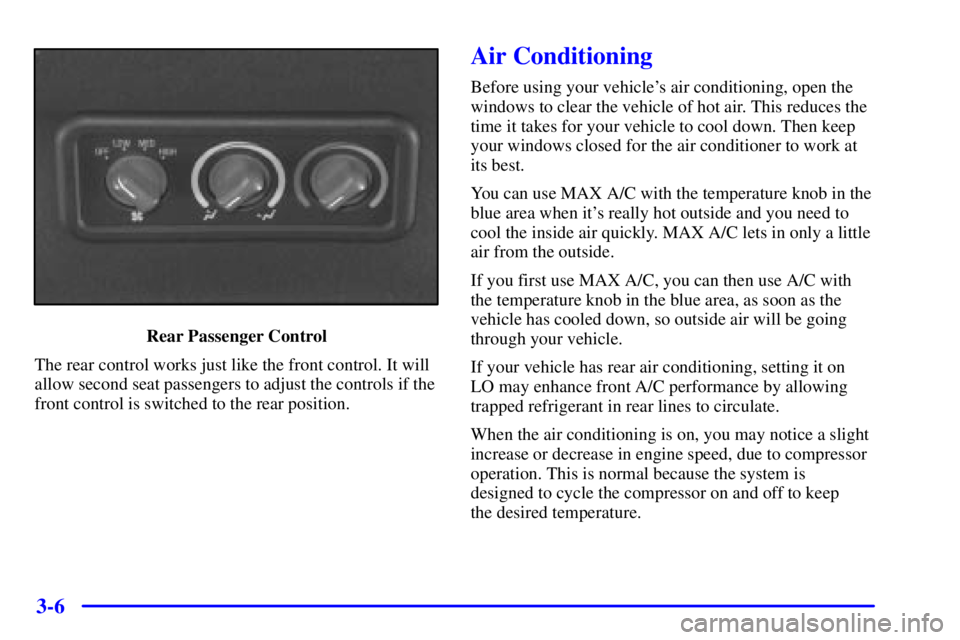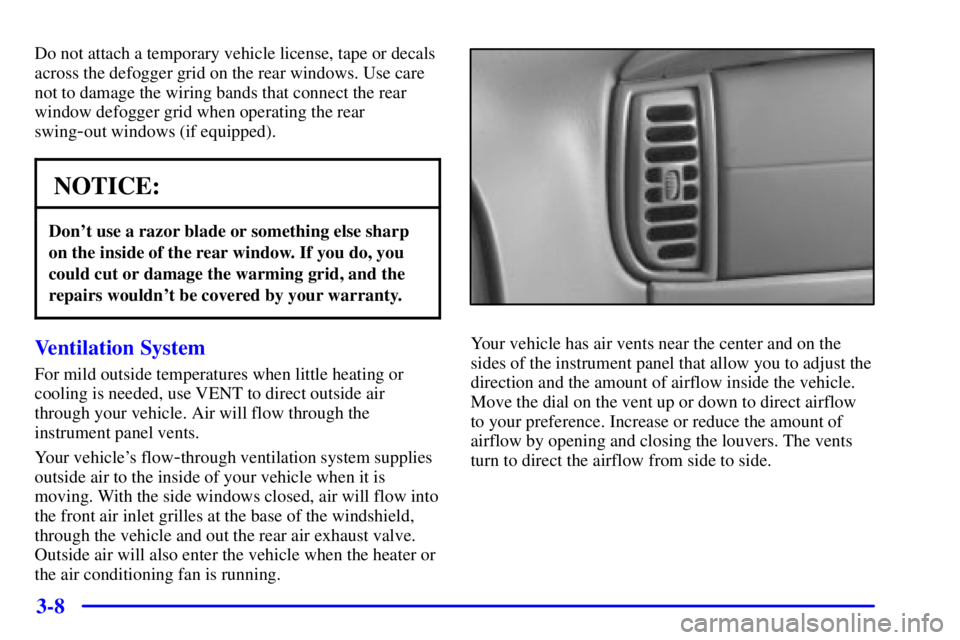Page 148 of 412

3-4
A/C: This setting is used for normal cooling on hot
days. It cools outside air and directs it through the
instrument panel outlets.
BI-LEVEL A/C: This setting divides airflow
between the heater floor vents and instrument panel
vents. The air conditioning compressor will cycle
continuously in this setting as long as the outside air
temperature is warm enough to activate the compressor.
VENT: This setting directs air through the
instrument panel vents.
HEAT: This setting directs air through the heater
floor vents. It is useful for cold weather.
HEAT/DEFOG: This setting divides airflow
between the heater floor vents and the windshield. In the
blended position, the air conditioning compressor is
automatically activated to dehumidify the air.
DEFROST: This setting directs air through the
windshield defroster vents. It is useful when you have
fog or ice on the windshield.
Rear Heater (Without Air Conditioning)
(If Equipped)
If you have a rear heater (without rear air conditioning),
the control is located on the instrument panel.
To increase and decrease the flow of heated air to the
rear floor vents, turn the thumbwheel marked REAR
HEAT to the speed you want.
The thumbwheel has three speed positions. To increase
the flow of heated air, turn the thumbwheel toward
HIGH. To turn the fan off, turn the control to OFF.
Page 149 of 412
3-5 Rear Air Conditioning and Rear Heater
(If Equipped)
If your vehicle has a rear air conditioning and rear
heater system combination, controls are provided
to regulate the temperature, location and speed of
the airflow.
Front Passenger ControlTo adjust the air temperature, turn the temperature knob
on the right side of the control panel.
For warmer air, turn the knob toward the red area, and
for cooler air, turn the knob toward the blue area.
To regulate the airflow location, adjust the center knob
on the control panel. Turn the knob counterclockwise
for floor vent airflow or clockwise for headliner vent air
flow. Generally, the upper vents are used for air
conditioning and the floor vents for heating. The control
knob can be set to any blend setting.
To adjust the airflow speed, turn the fan knob on the left
side of the control panel to the desired fan speed.
To activate the rear control, turn the fan knob on the
front control to REAR CNTL.
Page 150 of 412

3-6
Rear Passenger Control
The rear control works just like the front control. It will
allow second seat passengers to adjust the controls if the
front control is switched to the rear position.
Air Conditioning
Before using your vehicle's air conditioning, open the
windows to clear the vehicle of hot air. This reduces the
time it takes for your vehicle to cool down. Then keep
your windows closed for the air conditioner to work at
its best.
You can use MAX A/C with the temperature knob in the
blue area when it's really hot outside and you need to
cool the inside air quickly. MAX A/C lets in only a little
air from the outside.
If you first use MAX A/C, you can then use A/C with
the temperature knob in the blue area, as soon as the
vehicle has cooled down, so outside air will be going
through your vehicle.
If your vehicle has rear air conditioning, setting it on
LO may enhance front A/C performance by allowing
trapped refrigerant in rear lines to circulate.
When the air conditioning is on, you may notice a slight
increase or decrease in engine speed, due to compressor
operation. This is normal because the system is
designed to cycle the compressor on and off to keep
the desired temperature.
Page 151 of 412

3-7
Heating
On cold days, use HEAT with the temperature knob in
the red area. Outside air will be brought in through the
floor outlets. The heater works best if you keep your
windows closed while using it.
If you use the optional engine coolant heater before
starting your engine, your heating system will produce
warmer air faster to heat the passenger compartment in
cold weather. See ªEngine Coolant Heaterº in the Index.
Defrosting
Use DEFROST to remove fog or ice from the
windshield quickly in extremely cold conditions. The
temperature knob should be in the red area and the fan
knob toward high. The air conditioning compressor may
operate in this setting to dehumidify the air.
Rear Window Defogger (If Equipped)
If you see lines running across the rear windows, you
have a rear window defogger. The lines warm the glass.
For best results, clear the windows of as much snow or
ice as possible before using the rear window defogger.
To turn on the rear window
defogger, press this button
located near the fan control.
An indicator light in the
button will come on when
the rear window defogger
is working.
The rear window defogger will only work when the
ignition is in RUN.
The rear window defogger will turn itself off after
several minutes. If you need additional warming time,
press the button again. Pressing the button when the
indicator light is illuminated will turn the defogger off.
If your vehicle is equipped with heated outside rearview
mirrors, the rear window defogger button will activate
both the rear window defogger and the heated outside
rearview mirrors. See ªHeated Outside Rearview
Mirrorsº in the Index.
Page 152 of 412

3-8
Do not attach a temporary vehicle license, tape or decals
across the defogger grid on the rear windows. Use care
not to damage the wiring bands that connect the rear
window defogger grid when operating the rear
swing
-out windows (if equipped).
NOTICE:
Don't use a razor blade or something else sharp
on the inside of the rear window. If you do, you
could cut or damage the warming grid, and the
repairs wouldn't be covered by your warranty.
Ventilation System
For mild outside temperatures when little heating or
cooling is needed, use VENT to direct outside air
through your vehicle. Air will flow through the
instrument panel vents.
Your vehicle's flow
-through ventilation system supplies
outside air to the inside of your vehicle when it is
moving. With the side windows closed, air will flow into
the front air inlet grilles at the base of the windshield,
through the vehicle and out the rear air exhaust valve.
Outside air will also enter the vehicle when the heater or
the air conditioning fan is running.
Your vehicle has air vents near the center and on the
sides of the instrument panel that allow you to adjust the
direction and the amount of airflow inside the vehicle.
Move the dial on the vent up or down to direct airflow
to your preference. Increase or reduce the amount of
airflow by opening and closing the louvers. The vents
turn to direct the airflow from side to side.
Page 153 of 412

3-9
When you close a vent, it will increase the flow of air
coming out of any vents that are open.
If you have rear heating or rear air conditioning, you
will have adjustable vents in the rear of the vehicle to
help direct the airflow. The rear air conditioning vents
are located in the headliner at the rear of the vehicle.
The rear heating vents are located next to the second
and third seat on the driver's side of the vehicle, near
the floor. You can move the vents to direct the flow of
air, or close the vents altogether. When you close a vent,
it will increase the flow of air coming out of any vents
that are open.Ventilation Tips
�Keep the hood and front air inlet free of ice, snow, or
any other obstruction (such as leaves). The heater
and defroster will work far better, reducing the
chance of fogging the inside of your windows.
�When you enter a vehicle in cold weather, turn the
blower fan to HI for a few moments before driving
off. This helps clear the intake ducts of snow and
moisture, and reduces the chance of fogging the
inside of your windows.
�Keep the air path under the front seats clear of
objects. This helps air to circulate throughout
your vehicle.
Your vehicle has air vents in the center and on the sides
of your instrument panel.
You can move the vents from side to side or up and
down to direct the flow of air, or close the vents
altogether. When you close a vent, it will increase the
flow of air coming out of any vents that are open.
Page 206 of 412

4-14
A cornering skid and an acceleration skid are best
handled by easing your foot off the accelerator pedal.
If your vehicle starts to slide, ease your foot off the
accelerator pedal and quickly steer the way you want the
vehicle to go. If you start steering quickly enough, your
vehicle may straighten out. Always be ready for a
second skid if it occurs.
Of course, traction is reduced when water, snow, ice,
gravel or other material is on the road. For safety, you'll
want to slow down and adjust your driving to these
conditions. It is important to slow down on slippery
surfaces because stopping distance will be longer and
vehicle control more limited.
While driving on a surface with reduced traction, try
your best to avoid sudden steering, acceleration or
braking (including engine braking by shifting to a lower
gear). Any sudden changes could cause the tires to slide.
You may not realize the surface is slippery until your
vehicle is skidding. Learn to recognize warning
clues
-- such as enough water, ice or packed snow on
the road to make a ªmirrored surfaceº
-- and slow
down when you have any doubt.
Remember: Any anti
-lock brake system (ABS) helps
avoid only the braking skid.
Driving at Night
Night driving is more dangerous than day driving.
One reason is that some drivers are likely to be
impaired
-- by alcohol or drugs, with night vision
problems, or by fatigue.
Page 245 of 412

5-11 If No Steam Is Coming From Your Engine
If you get an engine overheat warning but see or hear no
steam, the problem may not be too serious. Sometimes
the engine can get a little too hot when you:
�Climb a long hill on a hot day.
�Stop after high
-speed driving.
�Idle for long periods in traffic.
�Tow a trailer. See ªDriving on Gradesº in the Index.
If you get the overheat warning with no sign of steam,
try this for a minute or so:
1. If you have an air conditioner and it's on, turn it off.
2. Turn on your heater to full hot at the highest fan
speed and open the window as necessary.
3. If you're in a traffic jam, shift to NEUTRAL (N);
otherwise, shift to the highest gear while
driving
-- DRIVE (D) or THIRD (3).If you no longer have the overheat warning, you can
drive. Just to be safe, drive slower for about 10 minutes.
If the warning doesn't come back on, you can
drive normally.
If the warning continues, pull over, stop, and park your
vehicle right away.
If there's still no sign of steam, push down the
accelerator until the engine speed is about twice as fast
as normal idle speed for at least three minutes while
you're parked. If you still have the warning, turn off the
engine and get everyone out of the vehicle until it
cools down.
You may decide not to lift the hood but to get service
help right away.